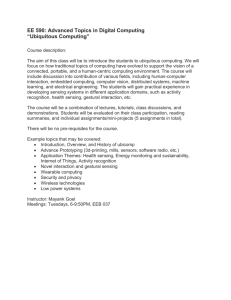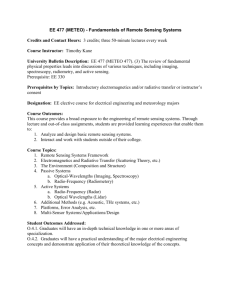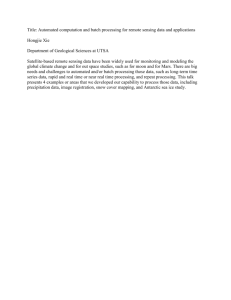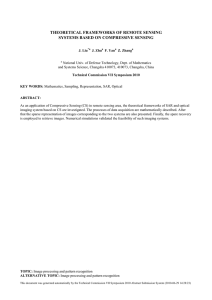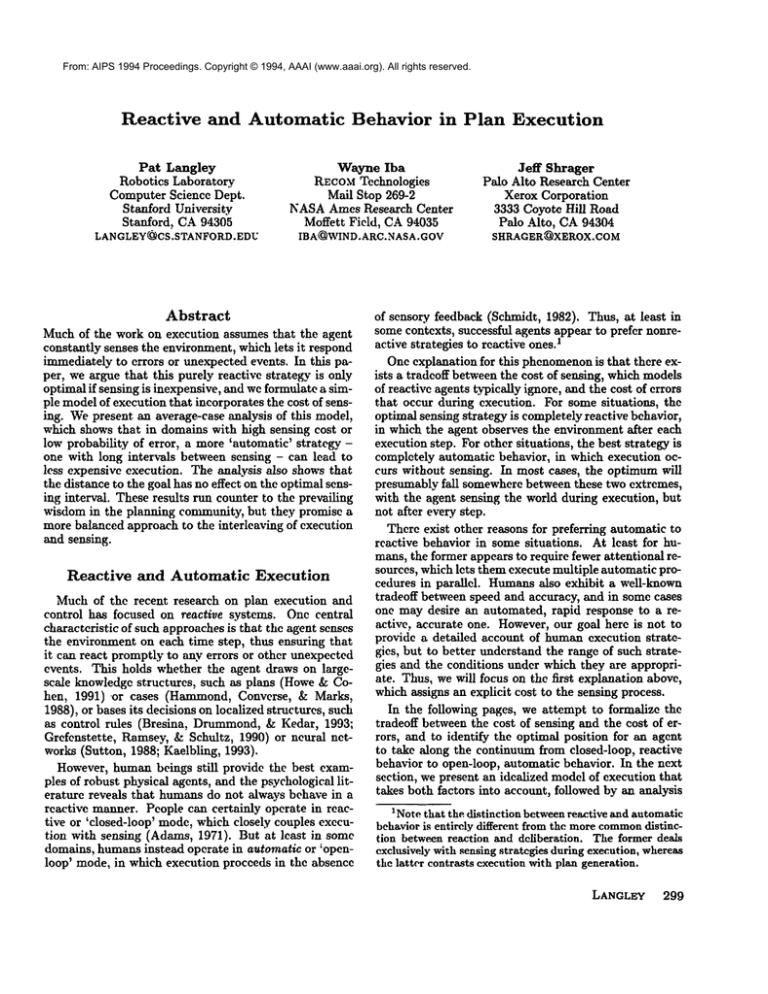
From: AIPS 1994 Proceedings. Copyright © 1994, AAAI (www.aaai.org). All rights reserved.
Reactive
and Automatic
Behavior
in Plan Execution
Pat Langley
Wayne Iba
Robotics Laboratory
REco.~Technologies
Computer Science Dept.
MailStop269-2
Stanford University
NASA Ames ResearchCenter
Stanford, CA 94305
MoffettField,CA 94035
LANGLEY(~CS.STANFORD.EDU
IBAC~WIND.ARC.NASA.GOV
Abstract
Much of the work on execution assumes that the agent
constantly senses the environment, which lets it respond
immediately" to errors or unexpected events. In this paper, we argue that this purely reactive strategy is only
optimal if sensing is inexpensive, and wc formulate a simple modelof execution that incorporates the cost of sensing. Wepresent, an average-case analysis of this model,
which shows that in domains with high sensing cost or
low probability of error, a more ’automatic’ strategy one with long inter~als between sensing - can lead to
less expensive execution. The analysis also shows that
the distance to the goal has no effect on the optimal sensing interval. These results run counter to the prevailing
wisdom in the planning community, but they promise a
more balanced approach to the interleaving of execution
and sensing.
Reactive
and
Automatic
Execution
Much of the recent research on plan execution and
control has focused on reactive systems. Onc central
characteristic of such approaches is that the agent senses
the environment on each time step, thus ensuring that
it can react promptly to any errors or othcr unexpected
events. This holds whether the agent draws on largescale knowledge structures, such as plans (Howe& Cohen, 1991)or cases (Hammond, Converse, & Marks,
1988), or bases its decisions on localized structures, such
as control rules (Bresina, Drummond,& Kedar, 1993:
Grefenstette, Ramsey, & Schultz, 1990) or neural networks (Sutton, 1988; Kaelbling, 1993).
However, human beings still provide the best examples of robust physical agents, and the psychological literature reveals that humans do not always behave in a
reactive manner. People can certainly operate in reactive or ’closed-loop’ mode, which closely couples execution with sensing (Adams, 1971). But at least in some
domains, humans instead operate in automatic or ’openloop’ mode, in which execution proceeds in the absence
Jeff Shrager
Palo Alto Research Center
Xerox Corporation
3333 Coyote Hill Road
Palo Alto, CA94304
SHRAGER~XEROX.COM
of sensory feedback (Schmidt, 1982). Thus, at least
some contexts, successful agents appear to prefer nonreactive strategies to reactive ones)
One explanation for this phenomenonis that there exists a tradeoff between the cost of sensing, which models
of reactivc agents t~-pically ignore, and the cost of errors
that occur during execution. For some situations, the
optimal sensing strategy is completely reactive behavior,
in which the agent observes the environment after each
execution step. For other situations, the best strategy is
completely automatic behavior, in which execution occurs without sensing. In most cases, the optimum wiU
presumably fall somewhere between these two extremes,
with the agent sensing the world during execution, but
not after every step.
There exist other reasons for preferring automatic to
reactive behavior in some situations. At least for humans, the former appears to require fewer attentional resources, which lets them execute multiple automatic procedures in parallel. Humansalso exhibit a well-known
tradeoff between speed and accuracy, and in some cases
one may desire an automated, rapid response to a reactive, accurate one. However, our goal here is not to
provide a detailed account of human execution strategies, but to better understand the range of such strategies and the conditions under which they are appropriate. Thus, we wiU focus on the first explanation above,
which assigns an explicit cost to the sensing process.
In the following pages, we attempt to formalize the
tradeoff between the cost of sensing and the cost of errors, and to identify the optimal position for an agent
to take along the continuum from closed-loop, reactive
behavior to open-loop, automatic behavior. In the next
section, we present an idealized model of execution that
takes both factors into account, followed by an analysis
1 Note that the distinction betweenreac.ti~e and automatic
behavior is entirely different from the morecommon
distinction between reaction and deliberation. The former deals
cxclusively with sensing strategies during execution, whereas
the latter contrasts execution with plan generation.
LANGLEY 299
of this
AfterCopyright
this, ©
we1994,
present
theoretical
From: AIPS
1994 model.
Proceedings.
AAAI some
(www.aaai.org).
All rights agent
reserved.
aw~,
from the desired path, and the distance d (or
the number of time steps) to the goal if no such errors
occur during execution.
There exist a "~ariety of ways to ground these terms.
Wemight model the situation geometrically, assuming
A Model of Execution Cost
that each error introduces some angular divergence from
the current path, and that error recovery involves changWewould like some model of execution that lets us
ing the angle of motion back toward the goal. Wecould
understand the tradeoff between the cost of sensing and
then determine the expected distance added to the exthe cost of errors. Of course, any model is necessarily
ecuted path as a function of the error-free distance, the
an idealization of some actual situation, and from the
probability and amount of error, and the sensing intermanypossible models, we must selcct one that is simulval. Combiningthis with the sensing cost, we could detaneously plausible and analytically tractable. Thus, we
rive the expected cost of execution. Note that this model
will begin with a realistic scenario and introduce some assumesthat errors have persistence; that is, the cost of
simplifying assumptions that we hope retain the essenan error increases with the time it goes undetected.
tial characteristics.
Although such a geometric model has attractions,
a
One commonproblem that involves physical agents
considerable amount of AI research (including muchwork
is robot navigation. In some approaches, the agent reon navigation) has relied instead on a state-space formaltrieves or generates a plan for moving through an enviism. For example, one can divide any two-dimensional
ronment, then executes this plan in the physical world.
region into a grid, with the typical location having four
Unfortunately, the plan does not always operate as deneighbors (up, down, left, and right). One can represent
sired. One source of divergence from the planned path
these locations as states in a problem space, and the accomes from actuator error: a commandto turn 35 detions connecting them as operators for moving from one
grees or to move 5.2 meters ahead may not execute exstate to another. A particular path through this space
actly as specified. Another source of divergence comes
corresponds to a navigation plan that the agent intends
from external forces: another agent may bump into the
to carry out, and if the operators along the path are unrobot or aa unexpected slope may alter its direction.
certain, then tile agent may diverge from the planned
Similar issues arise in the control of planes and boats,
path during execution. Such models of agent behavior
where malfunctioning effectors or unpredictable forces
are commonlyused in work on reinforcement learning
like wind can take the craft off the planned course.
(e.g., Sutton, 1988; Kaelbling, 1993).
In the standard reactive control regimen, the agent
Wecould directly analyze the tradeoff between sensing
senses the environment on every time step, detects errors
and execution costs within this two-dimensional frameordivergences
as soonastheyoccur,
antitakesaction
to work. However, Shrager, Hogg, and Huberman (1988)
2 Thequality
puttheagentbackon thedesired
path.
of
have noted that, for sparsely connected state spaces and
theresulting
planexecution
takesintoaccount
thenum- accurate control decisions, one can approximate search
berof stepsrequired
to reachthegoalor somesimilar through the space as a one-dimensional random walk,
measure.
In a moregeneralframework,
execution
qual- with each step taking one either closer to the goal (with
ityalsotakesintoaccount
thecostc of sensing,
which probability 1 - p) or further away(with probability p).
discourages
a rational
agentfromunnecessary
sensing Wccan adapt this idea to the execution of a state-space
andleadsit to sampletheenvironment
onlyafterevery plan, giving the model that we will use in the remainder
s timesteps.Thissensing
costm~."actually
addto the of the paper.
execution
time,or it maydrawon otherresources;
here
Figure 1 depicts this idealized situation. The agent,
we careonlythatit somehow
contributes
to theoverall
located at the current state, is moving toward the goal
costofexecution.
state, which is d steps to the right. With probability
Forsuchnavigation
contexts,
we wouldliketo deter- 1 -p, the agent’s next action will take it one step closer
minetheoptimal
sensing
interval
s fortheexecution
of to the goal. However,with probability p, the action will
a givenplan;in otherwords,wc wouldlikethesensing instead introduce an error that not only takes it one
interval
s thatproduces
themostdesirable
compromise step further from the goal, but reverses the agent’s dibetweenpurelyreactive
andpurelyautomatic
control. rection, so that future steps (unless again reversed) will
Naturally,
thebestvaluefors willbe partly
determined lead awayfrom the goal. (This persistent effect of errors
by thesensing
costc, whichwe assume
includes
thecost distinguishes the model from a simple random walk, in
of matching
theresultagainst
theexpected
situation. which the probability of moving in a given direction is
Twocharacteristics
of theplan’sinteraction
withthe independent of past events.) The agent can correct this
environment
alsocomeintoplay:theprobability
p that, situation, but it can only detect the problem through
on a giventimestep,an errorwilloccurthattakesthe sensing, which has cost c, leading it to sample the environment only after every s time steps.
2Insomework(e.g.,
Simmons,
1990),
theresults
ofsensing
Although this model is remarkably simple, we believe
instead
determine
thepathfollowed
ina conditional
plan,
but
herev,xassume
theaimistofollow
a single
desired
path.
that it provides a viable approximation for muchof the
curves that illustrate the behavioral implications of the
analysis. Finally, we discuss related work on sensing and
execution, along with someprospects for future research.
300
POSTERS
From: AIPS 1994 Proceedings. Copyright © 1994, AAAI (www.aaai.org). All rights reserved.
cost c
distanced
!
...
p~
1-p
V
current
state
I
sensingintervals
!
goal
state
Figure I. Modelingexecution as a ’persistent’ randomwalk in whichthe agent is distance d from the goal state, an execution
error that inverts the direction of movement
occurs with probability p, and sensing occurs every s time steps with cost c.
work on reactive behavior. The framework seems especially appropriate for navigation in a discretized twodimensional space, as assumed by Sutton (1988) and
Kaelbling (1993). Here each node in the state space has
no more than four neighbors, provided one allows only
moves to adjacent locations or changes in orientation. A
large set of states produces a sparsely connected space;
thus, unless errors are very likely, the situation can be
approximated by the random walk in our model.
Analysis
of the
Execution
Model
Within the above framework, we would like to determine O(c, s,p, d), the expected overall cost of executing
a plan given agent parameters for the sensing cost c and
sensing frequency s, and given domain parameters for
the error rate
p and distance
O(c,s,p,d)
= s d. This quantity is
where the first term in the product corresponds to the
cost per execution step (assuming unitary cost for each
movement) and the second gives the expected number of
steps during execution. Wecan further decompose the
latter term into
d
E(s,p,d) = S. G(s,p)
where the ratio on the right expresses the expected number of times the agent will have to sense during the execution process. This is simply the initial distance to
the goal, d, divided by the expected number of steps
taken toward the goal during the intra-sensing inter~al
8, denoted as G(s,p). Wecan expand this last term to
$
G(s,p)n(j, s, p). Q(j, 8) ,
j--O
where R(j, s,p) is the probability that exactly j errors
will occur during the sensing inter~al s and Q(j, 8) is the
expected number of steps taken toward the goal during
that interval given that exactly j errors have occurred
within it.
The first of these terms follows a simple binomial distribution, giving the expression
"-j
R(j,s,p)=
~)pJ(1-p)
The second term is more complex, but the basic idea
is that the j errors can occur during the s time steps
in any one of (3) ways, with equal probability. Wecan
determine the expected progress toward (or away from)
the goal resulting from any one of the errors, then compute a weighted average. As a special case, if the agent
makeszero errors, we have Q(0, s) = s, since each of the
s steps takes it toward the goal. Another special ease occurs when the agent makes exactly one error. Westart
with the expression
S--I
Q(1, s) = l ~ i - (8 - i)
8
i----0
since the error can occur before any one of the s time
steps, and the resulting progress in each case is the number of time steps prior to the error (i up to s - 1), minus the negative progress occurring during the remaining
time steps (s - i). If we simplify this expression, we see
that Q(1, s) = -1.
Whenthe agent makes two or more errors, the expected progress between the two errors (subsequent to
the first) are additive inverses and therefore tend to canccl each other. Thus, whenever the number of errors
is even, they cancel completely and the overall cxpected
progress is simply the expected progress prior to the first
error. Wecan express this quantity as
Q(J,8)
j -1
which averages, with respect to the total numberof ways
the j errors can occur, the progress prior to the first error
weighted by the number of ways that subsequent errors
can occur.
For the case in which the numberof errors is odd, all
but one of the subsequent errors cancel; thus, we must
include the expected progress between the first and second errors. Since we assume the agent starts in the right
direction, the first error results in negative progress and
we must subtract this term from the previous expression.
Thus, for this situation Q(j, 8) becomes
s--j
(~)
ti=o-
s-js--j--i+l/
j-ll))-i--~o
k(s
k~=l
-2
(;+1)
k)]
LANGLEY 301
"
From: AIPS 1994 Proceedings. Copyright
© 1994, AAAI (www.aaai.org). All rights reserved.
i0
sensinR co~t lC)
error ~=bahLii,-.y
8
U.4
Ip)
03
6
92"
O.l
125
IGO"
20~ "
35"
0
0
50 "
If..O--
o
25"
2
se.nging ;r,terva|(s)
8
4
~/
10
Figure2. Effect of the sensinginterval s and tile sensing cost
c on the o~rall execution cost O, whenthe error probability
p is 0.06 and the distance d to the goal is ten.
F/gure 3. Effect of the sensing interval s and the error probability p on the overall execution cost O, whenthe sensing
cost c is thrc.e and the distance d to tile goal is seven.
Given the above expressions and settings for the four
parameters, we can predict the expected overall cost
O(c, s, p, d) of executing a plan. Clearl)~ we would like
to select a sensing inter~al s that minimizes this cost.
For particular values of sensing cost c, error probability p, and distance d, we could in principle determine
this optimal value by taking the partial derivative of 0
with respect to s, setting this expression to zero, and
solving for s. Weare currently working on this step of
the analysis, but we have not yet obtained a closed-form
solution.
le~t expensive execution, with the cost monotonically
increasing with higher ~dues of s. This is the situation
that most papers on reactive behavior assume. However,
as the sensing cost increases, an intermediate strategy
becomesoptimal; for instance, when c is three, the best
setting for s is six. Moreover, when c reaches ten, we
find that the original effect is completely reversed, with
an almost completely automatic strategy being most desiralfle, and with the cost monotonically increasing as s
decreases.
A similar interaction emerges in Figure 3, which plots
O as a function of the sensing interval s and the probability of error p whenthe sensing cost c is three and the
distance d is seven. In this case, we see that, whenthe
chances of an error during an execution step is very high
(0.4), a purely reactive strategy proves least expensive.
Yet when the planned course of action becomes more
reliable (i.e., whenp decreases), sensing on every time
step ceases to be optimal and an intermediate strategy
emerges as most desirable. For example, when p = 0.2,
the optimal ~lue for s is three. Finally, when the execution of a plan is sufficiently reliable (whenp -- 0.05),
a completely automatic execution scheme becomes the
strategy of choice.
However, the sensing inter~.~l does not interact with
the final parameter, the distance d to the goal. Figure 4
maps the values of O against these two ~ariables when
the sensing cost is five and the error probability is 0.1.
The graph reveals that the optimal setting for s is five,
independent of the distance d, and similar results hold
for other values of c and p. Thus, in our model an agent
need not be concerned about its distance from the goal
whenselecting a sensing interval.
The behavioral implications of the model should now
bc clear. As the graphs show, there exist situations in
which a purely reaztivc strategy leads to the lowest execution costs, but when one takes the sensing cost into
Behavioral
Implications
of the
Analysis
Although the equations in the previous section provide an analytic model of execution and sensing, their
implications are not obvious. In order to better understand the interactions amongthe agent and environment
parameters, and their effects on the overall execution
cost, we carried out three ’thought experiments’. 3 In
each case, wc varied the sensing interval s and one other
parameter, with the aim of illuminating the tradcoff between the costs of sensing and action. Our intent was
not to show that one method is universally better than
another, but to show exactly the opposite: that there are
some situations in which reactive behavior outperforms
automatic processing, but that there also exist cases in
which automatic behavior is superior.
Figure 2 shows the joint effects of s and the sensing
cost c on the overall cost O(c,s,p,d), when the probability of error p is held constant at 0.06 and the distance
d to the goal is ten. Here we see that, whenthe sensing
cost c is zero, a purely reactive strategy produces the
3"tVe also ran actual experiments, using the same assumptions, a.s a check on our mathematicalanalysis. Since the results of these studies agreed closely with the predicted ones.
we have not reported thcm here.
302
POSTERS
From: AIPS 1994 Proceedings. Copyright © 1994, AAAI (www.aaai.org). All rights reserved.
Our work does have much in common with the approach taken by Iba (1991), who studied the continuum
from closed-loop to open-loop behavior in the execution
of retrieved motor schemas. However, Iba’s aim was to
minimize divergence of the execution trace from the de150
5
10
sired behavior, and he ignored the cost of sensing. Yang
(1992) has also dealt with the continuum in his work
0 109 .
macro-operators, showing that some environments support long sequences of actions without sensing, whereas
$0.
others do not. But again, his work assumed sensing
0
2
4
6
should be minimized but did not model its cost.
The research most closely related to our own comes
from Hansen and Cohen (1993), who have reformulated
the standard Markov decision framework to incorporate
the cost of sensing. Their analysis shows that, in some
10
domains, selective sensing can produce less expensive execution strategies than purely reactive schemes, and that
F~gure4. Effect of the sensing interval s and the distance d
one can use dynamic programming to determine the opto the goal on the o~rall execution cost O, whenthe sensing
timal monitoring interval. Moreover, they show that the
cost c is fix~ and there exists a 0.1 probability of error.
desired
intert~l
decreases
as theagentapproaches
the
finalstate,
anintuitively
plausible
result
thatouranalysisdocsnotprovide.
However,
theirframework
differs
account, there also exist manycases in which a rational
from
our
own
in
assuming
a
cyclical
domain,
so
that
we
agent should sense only occasionally or even use a purely
cannot
directly
carryovertheirresults.
automatic strategy that involves no sensing at all. The
literature’s emphasis on reactive behavior has comefrom
Although
our modelmovesbeyondmostothersin its
an oversimplified model that assumes the cost of sensexplicit
treatment
ofsensing
costs,
considerable
workreing is negligible. This assumption is dearly violated for
mainsto be done.We shouldconnectour theoretical
humans, and we believe that robust artificial agents will
ideasto moretraditional
decision-theoretic
analyses,
and
also be forced to take sensing costs into account.
we shouldtesttheframework’s
ability
to modelthebehaviorof physical
robotsusingactualnavigation
plans
and
using
reasonable
estimates
of
sensing
cost.
We
have
Related and Future Work
alsomadethe implausible
assumption
thatonesensing
inter,~
is optimal
foran entire
plan,andwe should
exAs wc noted earlier, the majority of research on extendthemodelto handleplanswitha numberof sequenecution has assumed a purely reactive strategy. Most
tialcomponents,
eachwiththeirownvalues
forthep, d,
examples of this approach rely on local decision knowlc,
and
s
parameters.
edge (e.g., Sutton, 1988; Bresina et al., 1993), but even
work that involves the generation or retrieval of entire
Moreover,
we shouldgeneralize
theframework
to hanplans (e.g., Howe& Cohen, 1991; Hammond
et al., 1988)
dlesituations
thatinvolve
manydifferent
sensors,
each
On everytimestep,the
hasoftenassumed
thattheagentsensestheenvironment withits owncharacteristics.
on everytimestep,givingit theability
to reactimme- decision
aboutwhether
to invokea givensensorshould
diatelywhenbehavior
diverges
fromthedesiredpath. takeintoaccountnotonlythatsensor’s
expense,
but
Research
in thistradition
almostinvariably
ignores
the also the information it is expected to provide, which is
costofsensing.
directly related to the probability that the sensor will reA few researchers
haveincorporated
decisions
about veal an execution error. In this framework, the optimal
sensing
intotheprocess
ofplangeneration,
viewing
these strategy would sample inexpensive, informative sensors
as a formof action(Simmons,
1990;Kresbachet al., frequently but sample costly, uninformative ones seldom
1991;Schoppers,
1991).However,
thisworkhasfocused or not at all, giving behavior that is reactive with respect
on theconstruction
of conditional
plansthatareguar- to some sensors and automatic with respect to others.
anteedto achieve
thegoal,ratherthanexplicitly
takFinally’, we would like the agent to determine the oping intoaccountthe sensingcost.Tan’s(1991)work timal sensing
inter~d
fora givensituation
by taking
the
on theinduction
of sensing
strategies
doesaddress
the derivative
ofO(c,s,p,d) withrespect
to s.However,
for
costof sensing,
butherethegoalis to determine
the
thisit mustknowthe~duesforthesensing
coste, the
mostefficient
sequence
of sensing
actions,
notthetrade- errorprobability
p, anddistance
d, andwe cannotexoffbetween
sensing
costsanderrorcosts.Chrisman
and pectan oracleto provide
thisinformation
on request.
Simmons(1991)assignclearcoststo bothsensingand
Fortunately-,
theagentshould
be ableto estimate
these
action,
buttheyemphasize
selection
of thcbestsensing parameter
settings
fromcxecution
ofthegivenplan,simdecision
on eachtimestep,ratherthanthedecision
of
plyby collecting
statistics
overa number
of trials.
Such
whether
tosenseat all.
a learning
agentwouldbeginwitha purely
reactive
stratd£atlmce to goal |d)
20
1
LANGLEY 303
From: egy
AIPSbut,
1994 if
Proceedings.
Copyright
© 1994, AAAI
(www.aaai.org).
All rightsGrefenstette,
reserved.
the parameter
estimates
recommend
it, would
move toward a more automatic execution scheme as it
gains experience.
An extended model of this sort makes clear predictions
about humanlearning. In particular, it indicates that,
in the early stages of skill acquisition, people will operate
in reactive modeto the extent their attentional resources
allow, letting them estimate the domain characteristics.
In uncertain domains where sensing is expensive, they
will continue to execute skills in this manner even after long practice. But in domains where sensing costs
less and errors are unlikely, they will gradually moveto
an automatic execution strategy. Unfortunately, most
existing studies of human motor behavior have forced
subjects into either closed-loop processing (e.g., Adams,
1971) or open-loop mode(e.g., Schmidt, 1982), and they
have not systematically ,~ricd the domain characteristics with an eye toward the transition from the former
to the latter. A clear test of our model would include
different types of motor tasks and would give subjects
the ability to range from automatic processing to purely
reactive behavior.
Webegan this paper with an intuition that ran counter
to the prevailing wisdomthat purely reactive strategies
are always preferable. In order to formalize our ideas, we
presented an idealized model of plan execution, followed
by a tractable analysis that predicts the overall cost of
execution in terms of the sensing inter~d s, the sensing
cost c, the probability of error p, and the distance d to
the goal. Our analysis, which we argued is applicable to
muchof the work in the Utcrature, revealed that it is not
always desirable to sense on every time step, and that
the parameters c and p (but not d) influence the optimal
setting for s. In future work, we plan to elaborate on
the start we have made here, and we hope that other
researchers will join us by taking a more balanced view
of the spectrum from reactive to automatic execution.
Acknowledgements
This research was supported in part by Grant F4962094-1-0118 from the ComputerScience Division of the Air
Force Office of Scientific Research.
References
Adams, J. A. (1971). A closed-loop theory of motor
learning. Journal of Motor Beha~,ior, 3, 111-149.
Bresina, J., Drummond,M., & Kedar, S. (1993). Reactive, integrated systems pose new problems for machine learning. In S. Minton (Ed.), Machine learning
methods for planning. San Mateo, CA: Morgan Kaufmann.
Chrisman, L., & Simmons, R. (1991). Sensible planning: Focusing perceptual attention. Proceeding o] the
Ninth National Conference on Artificial Intelligence
(pp. 756--761). Anaheim, CA: AAAIPress.
304
POSTERS
J. J., Ramsey, C. L., & Sehultz, A. C.
(1990). Learning sequential decision rules using simulation models and competition. Machine Lealming, 5,
355--381.
Hammond,K. J., Converse, T., & Marks, M. (1988).
Learning from opportunities: Storing and reusing execution-time optimization. Proceeding of the Seventh
National Conferenceon Artificial Intelligence (pp. 536-540). St. Paul, MN:AAAIPress.
Hansen, E. A., & Cohen, P. R. (1993). Learning monitoring strategies to compensatefor model uncertainty.
Working Notes of the AAAI-93 Workshop on Learning
Action Models (pp. 33-35). Washington, D.C.: AAAI
Press.
Howe,A. E., & Coheu, P. R. (1991). Failure recovery:
model and experiments. Proceeding of the Ninth National Conference on Artificial Intelligence (pp. 801808). Anaheim, CA: AAAIPress.
lba, W. (1991). Acquisition and improvement of human motor skills: Learning through obser~,ation and
practice. Doctoral dissertation, Department of Information & ComputerScience, University of California,
Irvine.
Kaelbling, L. P. (1993}. Hierarchical learning in stochastic domains: Preliminary results. Proceedings of the
Tenth International Conference on Machine Learning
(pp. 167-173). Amherst, MA.
Kresbach, K., Olawsky, D., & Gini, M. (1992). An empirical study of sensing and defaulting in planning.
Proceedings o] First International Conference on Artificial Intelligence Planning Systems (pp. 136-144).
College Park, MD: Morgan Kaufmann.
Schmidt, R. A. (1982). More on motor programs.
J. A. S. Kelso (Ed.), Humanmotor behavior: An introduction. Hillsdale, N J: Lawrence Erlbaum.
Shrager, J., Hogg, T., & Huberman, B. A. (1988).
graph-dynamic model of the power law of practice and
the problem-solving fan effect. Science, ~42,414--416.
Schoppers, M. (1992). Building plans to monitor and exploit open-loop and closed-loop dynamics. Proceedings
of First International Conferenceon Artificial Intelligence Planning Systems (pp. 204-213). College Park,
MD: Morgan Kaufmann.
Simmons, R. (1990). Robust behavior with limited resources. Proceedings o] the AAAI Spring Symposium
on Planning in Uncertain, Unpredictable, or Changing
Environments. Stanford, CA.
Sutton, R. (1988). Learning to predict by the methods
of temporal differences. MachineLearning, 3, 9--44.
Tan, M. (1991). Cost-sensitive robot learning. Doctoral
dissertation,
School of Computer Science, Carnegie
Mellon University, Pittsburgh, PA.
Yang, H. (1992). Learning and using macro-operators
for AIplanning. Doctoral dissertation, Department of
ComputerScience, Vanderbilt University, Nasilville.

